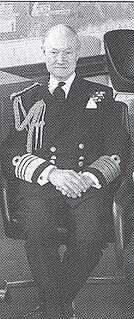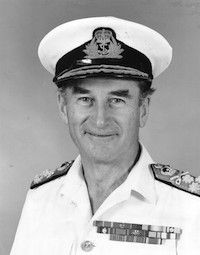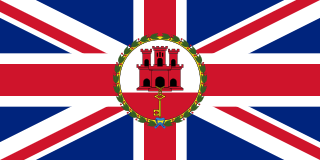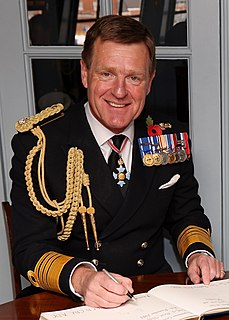Related Research Articles

The Second Sea Lord and Deputy Chief of Naval Staff is deputy to the First Sea Lord and the second highest-ranking officer to currently serve in the Royal Navy and is responsible for personnel and naval shore establishments. Originally titled Second Naval Lord in 1830, the post was restyled Second Sea Lord in 1904. They are based at Navy Command, Headquarters.

Admiral of the Fleet Michael Cecil Boyce, Baron Boyce, is a retired senior Royal Navy officer who now sits as a crossbench member of the House of Lords.
Admiral of the Fleet Sir David Benjamin Bathurst is a former Royal Navy officer. After training as a pilot and qualifying as a helicopter instructor, Bathurst commanded a Naval Air Squadron and then two frigates before achieving higher command in the Navy. He served as First Sea Lord and Chief of the Naval Staff from 1993 to 1995: in that capacity he advised the British Government on the deployment of Naval Support including Sea Harriers during the Bosnian War.

Admiral of the Fleet John David Elliott Fieldhouse, Baron Fieldhouse, was a Royal Navy officer. He commanded five submarines and a frigate before achieving higher command from the 1970s. Following the invasion of the Falkland Islands by Argentine forces in April 1982, Fieldhouse was appointed Commander of the Task Force given responsibility for "Operation Corporate", the mission to recover the Falkland Islands. The campaign ended in the surrender of Argentine forces in June 1982. He became First Sea Lord and Chief of Naval Staff in December that year and, in that role, persuaded the British Government to fund the replacement of ships lost in the Falklands War. He went on to be Chief of the Defence Staff from 1985 until his retirement in 1988.
Rear Admiral Peter Ross Sinclair, is a retired senior officer of the Royal Australian Navy who served as the 35th Governor of New South Wales from 8 August 1990 to 1 March 1996. Born in Manly, New South Wales, he was educated North Sydney Boys High School before joining the navy through the Royal Australian Naval College.

Rear Admiral Sir David James Martin, was a senior officer of the Royal Australian Navy and later Governor of New South Wales. He also established the Sir David Martin Foundation to assist young Australians in crisis.

Admiral Sir John Jeremy Black,, known as Jeremy Black or J. J. Black, was a senior Royal Navy officer. He commanded the aircraft carrier HMS Invincible during the Falklands War, and later served as Commander-in-Chief Naval Home Command from 1989 until his retirement in 1991.

Admiral of the Fleet Sir Henry Conyers Leach, was a Royal Navy officer who, as First Sea Lord and Chief of the Naval Staff during the early 1980s, was instrumental in convincing the British prime minister, Margaret Thatcher, that retaking the Falkland Islands from Argentina was feasible. On account of the determination he showed in the matter, journalist and political commentator Andrew Marr described him as Thatcher's "knight in shining gold braid".

Admiral of the Fleet Sir John Julian Robertson Oswald was a senior Royal Navy officer. After training as a gunnery specialist, Oswald commanded a frigate and then a destroyer before achieving higher command in the navy. He served as First Sea Lord and Chief of Naval Staff in the early 1990s. In that capacity he advised the British Government on the reduction in the size of the fleet under the Options for Change restructuring programme and on the deployment of Naval Support for the Gulf War in 1991: he also made the decision that members of the Women's Royal Naval Service should be allowed to serve in Royal Navy ships.

Admiral Sir Anthony Monckton Synnot, was a senior officer in the Royal Australian Navy, who served as Chief of the Defence Force Staff from 1979 to 1982.

Vice Admiral Sir Adrian James Johns, is a former senior officer in the Royal Navy, serving as Second Sea Lord between 2005 and 2008. He was the Governor of Gibraltar between 2009 and 2013.
Admiral Sir William Thomas Pillar, was a senior Royal Navy officer who served as Chief of Naval Support and a member of the Admiralty.

The Royal Naval College, Greenwich, was a Royal Navy training establishment between 1873 and 1998, providing courses for naval officers. It was the home of the Royal Navy's staff college, which provided advanced training for officers. The equivalent in the British Army was the Staff College, Camberley, and the equivalent in the Royal Air Force was the RAF Staff College, Bracknell.

Commodore Submarine Service is a post in the Royal Navy which involves command of the Royal Navy Submarine Service. It evolved from the post of Inspecting Captain of Submarines in 1901 and would later evolve to become the post of Flag Officer Submarines in 1944.

Admiral Sir Antony David Radakin, is a senior Royal Navy officer. He is presently the 24th Chief of the Defence Staff, the professional head of the British Armed Forces since November 2021, succeeding General Sir Nicholas Carter. Radakin also served as First Sea Lord, the professional head of the Naval Service from June 2019 to November 2021. He was Chief of Staff, Joint Forces Command, from 2016 to 2018, and the Second Sea Lord and Deputy Chief of the Naval Staff from 2018 to 2019.

Admiral Sir Benjamin John Key, is a senior Royal Navy officer. He has served as First Sea Lord since November 2021. He has commanded HM Ships Sandown, Iron Duke and Lancaster, and deployed on operations to Kosovo and Iraq. He was appointed Fleet Commander in 2016, and the Chief of Joint Operations in 2019.
Rear-Admiral Hugh Maxwell Balfour was a Scottish Royal Navy officer.

The Assistant Chief of the Naval Staff formerly the Assistant Chief of the Naval Staff is a senior Royal Navy appointment responsible for naval aviation. The post is also the successor to the Royal Navy's Flag Officer for naval aviation in the British Isles, established since 1939.

The Flag Officer, Royal Yachts, (FORY) also styled Flag Officer Commanding Royal Yachts was a senior Royal Navy post that existed from 1884 to 1997.
References
- ↑ "Garnier, Rear-Adm. Sir John", Who's Who (online ed., Oxford University Press, December 2018). Retrieved 1 July 2019.